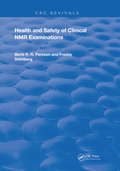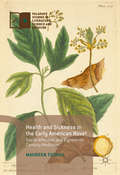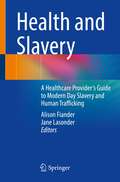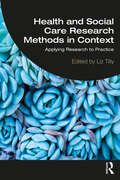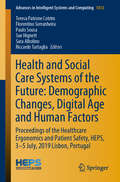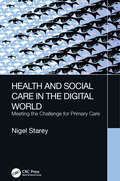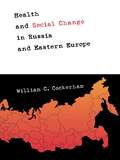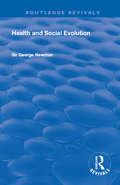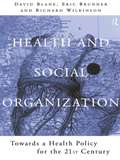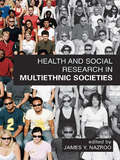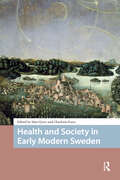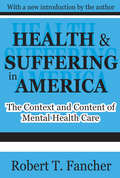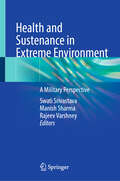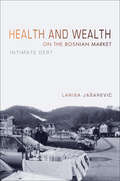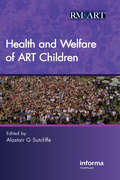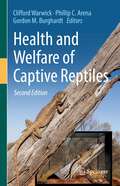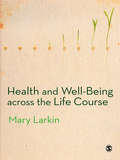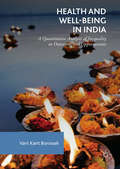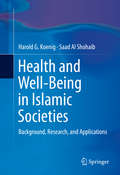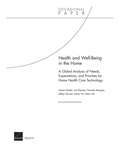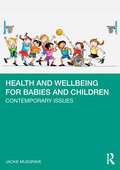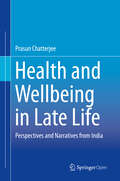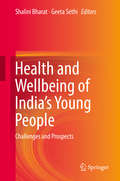- Table View
- List View
Health and Safety of Clinical NMR Examinations (Routledge Revivals)
by Bertil Persson Freddy R. StahlbergPublished in 1989: The short history of medical use of NMR is given. A brief introduction to the fundamental principles of NMR and the strategies of creating NMR image, as well as the exposure levels of various types of fields involved, are given.
Health and Sickness in the Early American Novel
by Maureen TuthillThis book is a study of depictions of health and sickness in the early American novel, 1787-1808. These texts reveal a troubling tension between the impulse toward social affection that built cohesion in the nation and the pursuit of self-interest that was considered central to the emerging liberalism of the new Republic. Good health is depicted as an extremely positive social value, almost an a priori condition of membership in the community. Characters who have the "glow of health" tend to enjoy wealth and prestige; those who become sick are burdened by poverty and debt or have made bad decisions that have jeopardized their status. Bodies that waste away, faint, or literally disappear off of the pages of America's first fiction are resisting the conditions that ail them; as they plead for their right to exist, they draw attention to the injustice, apathy, and greed that afflict them.
Health and Slavery: A Healthcare Provider's Guide to Modern Day Slavery and Human Trafficking
by Alison Fiander Jane LasonderAimed at Healthcare Professionals (doctors, nurses, allied professionals) and healthcare students, to raise awareness, recognition and guidance on what to do in the face of suspected Modern Slavery and Human Trafficking (MSHT). This textbook includes consideration of the size of the problem, MSHT indicators, important communication skills, the reporting of suspected cases and organisations working in the field. The majority of victims of MSHT come into contact with healthcare professionals (HCPs) at some point in their journey but HCPs report feeling ill equipped to recognise or manage a potential victim, (90% of victims of MSHT come into contact with a HCP but only 10% of HCPs know how to recognise victims and what to do). As such this topic should be represented in undergraduate and post graduate curricula. This textbook deals with the identification and appropriate management of suspected cases. It has been edited by Prof Alison Fiander and Ms Jane Lasonder and written by Healthcare professionals, Medical Students from the School of Medicine, Cardiff University as part of a Student Selected Component, Survivors of MSHT, and organisations working in the Human Trafficking field, including the UN.
Health and Social Care Research Methods in Context: Applying Research to Practice
by Liz TillyThis is the first textbook to show how research using a range of qualitative and quantitative methods relates to improving health and social care practice. The book shows how different research approaches are undertaken in practice and the challenges and strengths of different methodologies, thus facilitating students to make informed decisions when choosing which to use in their own research projects. The eleven chapters are each structured around different research methods and include: A brief overview of the research and research question Identification and overview of the research approach and associated methods selected to answer this question The sample and recruitment, including issues and challenges Ethical concerns Practical issues in undertaking the research approach Links between the research process and findings to health and social care values Links to the full research study Further reading The book will be a required reading for all students of social work; social care; nursing; public health and health studies and particularly suitable for those on widening participation courses.
Health and Social Care Systems of the Future: Proceedings of the Healthcare Ergonomics and Patient Safety, HEPS, 3-5 July, 2019 Lisbon, Portugal (Advances in Intelligent Systems and Computing #1012)
by Riccardo Tartaglia Sara Albolino Teresa Patrone Cotrim Florentino Serranheira Paulo Sousa Sue HignettThis book discusses how digital technology and demographic changes are transforming the patient experience, services, provision, and planning of health and social care. It presents innovative ergonomics research and human factors approaches to improving safety, working conditions and quality of life for both patients and healthcare workers. Personalized medicine, mobile and wearable technologies, and the greater availability of health data are discussed, together with challenges and evidence-based practice. Based on the Healthcare Ergonomics and Patient Safety conference, HEPS2019, held on July 3-5, 2019, in Lisbon, Portugal, this book offers a timely resource for graduate students and researchers, as well as for healthcare professionals managing service provision, planners and designers for healthcare buildings and environments, and international healthcare organizations.
Health and Social Care in the Digital World: Meeting the Challenge for Primary Care
by Nigel StareyThis provocative and timely book examines the current state of primary care practice and outlines a new vision for the delivery of primary care services, primarily in the UK but also internationally. Encouraging a social compact between citizens, governments and the providers of care, the book describes how this will necessitate a redesign of the welfare sector to ensure it is 'fit for purpose' in the digital world. It explores the respective roles of the inverse care law and the rule of halves, systems theory and learning organisations, mutuality and active citizenship, and how these can be applied to improve service delivery. Key Features Offers an alternative approach to thinking and a challenge to leaders within primary care and to those with administrative responsibility for the sector Reflects the multiple challenges facing primary care, including the rise in frail elderly patients, increasing multi-morbidities, the impact of changing demography with migration and much more Sets these challenges in a context of increasing workforce pressures, including changing attitudes to professionalism, burnout and recruitment difficulties Outlines a road map for improvement responding to current challenges around social care as well as digital/e-health Aimed at, and written for, all those committed to improving the future of the primary care sector in the UK and internationally, this important book will be of interest to students, clinicians, managers, commissioners, policy makers and service users. The Author Nigel Starey is a practicing GP, an academic GP and an advisor for the Care Quality Commission, UK.
Health and Social Change in Russia and Eastern Europe
by William C. CockerhamFor the first time, life expectancy is declining in an industrialized society. In this pioneering work, William C. Cockerham examines the social causes of the decline in life expectancy beginning in the 1960s including: *Russia *Poland *Hungary *Romania *Bulgaria *the Czech Republic *and East Germany. Health and Social Change in Russia and Eastern Europe argues that the roots of this change are mainly social rather than biomedical - the result of poor policy decisions, stress and an unhealthy diet. Cockerham presents a theory of postmodern social change that goes beyond the borders of Eastern Europe.
Health and Social Evolution: Halley Stewart Lectures, 1930 (Routledge Revivals)
by George NewmanOriginally published in 1931, this book explores the history of health and social evolution in the UK, including chapters on how England learned to control disease, the contribution of the eighteenth century, and the coming of democracy.
Health and Social Organization: Towards a Health Policy for the 21st Century
by Richard Wilkinson David Blane Eric BrunnerThere is widespread recognition that the most powerful determinants of health today are to be found in social, economic and cultural circumstances. These include: ecnomic growth, income distribution, consumption, work oganisation, unemployment and job insecurity, social and family structure, education and deprivation, and they are all aspects of 'social organisation'. In ^Health and Social Organisation leading British and North American researchers who bring together an invaluable collection of data on these issues, draw from the social sciences, epidemiology and biology.
Health and Social Research in Multiethnic Societies
by James Y. NazrooThis volume presents a ready source of information on the methodological issues facing research on ethnicity, which is highly relevant to a wide variety of health, economic and social issues in modern societies. Straightforward in its approach and accessible to those who are not specialists in studies of ethnicity, Health and Social Research in Multiethnic Societies provides essential and clear guidance on appropriate methods. Topics covered include: approaches to conceptualizing ethnicity and understanding the context of ethnicity in modern societies ethical issues and the political context within which ethnicity research is conducted engagement with researched communities, and with users more broadly cultural competence in research practical issues faced by both qualitative and quantitative research use of secondary and administrative data sources for research. Using a combination of critical analysis and case studies to illustrate the benefits and pitfalls of particular approaches, this volume provides access to core issues relevant to research with ethnic minority groups. It is a vital resource for those carrying out, and using, what is a considerable body of research, including students, academics, researchers, and research commissioners.
Health and Society in Early Modern Sweden (Premodern Health, Disease, and Disability)
by Mari Eyice Charlotta ForssThe understanding of what health is and how it can be maintained has changed through history. Questions like who can perform healing? and what sort of bodies are considered healthy? have elicited widely divergent responses in different societies. This volume explores how health was understood and practiced in the early modern Nordic region, with a focus on Sweden, including Finland. The chapters examine topics such as the dyslexia of Charles XI, lay perceptions of bodily and mental variability, and the health benefits attributed to using the sauna. Together, the essays give a holistic view of how practices of health evolved in close symmetry with societal institutions and localised worldviews. As such, the volume is a timely intervention into the social history of medicine, contributing to the historicisation of health as a concept and shedding light on developments in the Nordic world.
Health and Suffering in America: The Context and Content of Mental Health Care
by Robert T. FancherHealth and Suffering in America analyzes how we came to see various forms of suffering as "mental illness," and argues that social and historical dynamics, not scientific discovery, gave us this notion. Robert Fancher argues that the beliefs of mental health professionals have less to do with science than with the professions' own values and ideologies. The image we have of mental health care hides vast realms of unexamined assumptions. In effect, the author maintains that "mental health" consists of mental health professionals' ideas about how people ought to live and act, not discoveries about human nature. The body of the book consists of detailed analyses and critiques of four infl uential American cultures of therapy: psychoanalysis, behaviorism, cognitive therapy, and biological therapy. Fancher emphasizes how heavily their concepts and methods are determined by their cultures rather than by empirical data. Furthermore, our notions of mental health are not scientifi c discoveries, but moral ideals. Yet mental health workers often fail to understand this. As a result, they misunderstand their own authority and, worse, fail to subject their moral ideals to appropriate moral and cultural criticism. The new introduction by the author explores how the rise of managed health care coalesces with insistence on parity for mental health problems, supported by continuing claims that mental health care is science-based.
Health and Sustenance in Extreme Environment: A Military Perspective
by Rajeev Varshney Manish Sharma Swati SrivastavaThis book provides insights into the challenges of military operations under extreme climatic conditions. Divided into 3 sections, the book covers the impact of extreme environments from high altitude areas to desert terrain, forest conditions, and the marine environment. Chapters discuss the influence of altitude on military operations, the role of the microbiome, and innovative diagnostic and therapeutic approaches. It also addresses physiological solutions for desert warfare and the complexities of jungle operations. Further chapters describe the effects of marine motion and deep-sea challenges, covering strategies for health surveillance, psychological well-being, and precision medicine in combat scenarios. The book is supplemented with basic definitions, descriptive artwork, novel and unexplored research questions The book is relevant for physiologists, researchers in stress biology, and military medicine interested in understanding the impact of extreme climatic conditions on soldier health and performance.
Health and Wealth on the Bosnian Market: Intimate Debt
by Larisa JašarevicLarisa Jasarevic offers an unforgettable look at the everyday experiences of people living in post-socialist, post-war Bosnia. Not at all existing on the world's margins, Bosnians today are concerned with the good life and are as entangled in consumer debt as everyone else. The insecurities of living in an economy dominated by informal networks of trade, personal credit, and indebtedness are experienced by Bosnians in terms of physical ailments, some not recognized by Western medical science. Jasarevic follows ordinary Bosnians in their search for treatment—from use of pharmaceuticals to alternative medicines and folk healers of various kinds. Financial well-being and health are woven together for Bosnians, and Jasarevic adeptly traces the links between the two realms. In the process, she addresses a number of themes that have been important in studies of life under neoliberalism in other parts of the world.
Health and Welfare of ART Children (Genome Designing Of Crops Ser.)
by Alastair G SutcliffeThis comprehensive overview of the known literature concerning the physical and psychosocial health of children conceived by ART brings together an international panel of experts in fertility medicine, epidemiology, medical genetics, obstetrics, twin research, psychosocial development and pediatrics. Each chapter gives a concise, readable commentar
Health and Welfare of Brachycephalic (Flat-faced) Companion Animals: A Complete Guide for Veterinary and Animal Professionals
by Dr Rowena M. A. Packer Dr Dan G. O’NeillHealth and welfare issues of brachycephalic (flat-faced) animals are one of the most pressing problems facing companion animals right now. Dogs, in particular, are suffering from a ‘brachycephalic crisis’ resulting from a perfect storm where predispositions to an array of health issues are amplified by a population boom for certain brachycephalic breeds such as the French Bulldog and Pug. But yet, for many owners, these dogs represent the perfect companion: endearing personas and cute looks in a socially desirable package. So where is the truth in all of this? This book will equip veterinary professionals, animal welfare scientists, breeders and owners with the fuller story about brachycephalic health and welfare. The first half of the book provides the context of how and why we are in this crisis, offering in-depth historical, social, ethical, communication, nursing, welfare, epidemiological, genetics and international perspectives. The second half shifts towards the clinical arena, with chapters that cover the background, diagnosis, treatment and prevention of the many unique healthcare needs of brachycephalic animals. Cutting-edge knowledge is shared on a range of disciplines including respiratory disease, ophthalmology, dermatology, dentistry, neurology, obesity, reproduction and anesthesia. With twenty chapters written by world-leading experts, lifetimes of experience and knowledge are condensed into the first book dedicated exclusively to brachycephaly in companion animals. This essential reference resource will inform, challenge and stimulate; it will open your mind to new opportunities for you to improve the welfare of brachycephalic animals by your personal and collective choices and actions. But prepare to be surprised: you may just find that your views on brachycephaly in companion animals will be changed forever.
Health and Welfare of Captive Reptiles
by Gordon M. Burghardt Clifford Warwick Phillip C. ArenaThis extensively revised and expanded new edition offers concepts, principles and applied information that relates to the wellbeing of reptiles. As a manual on health and welfare in a similar vein to volumes addressing the sciences of anatomy, behaviour or psychology, this book thoroughly examines the biology of reptile welfare and is about meeting biological needs. The editors, acknowledged experts in their own right, have once again drawn together an extremely impressive international group of contributors. Positive and negative implications of general husbandry and research programs are discussed. In addition to greatly revised original content are nine new chapters offering readers novel insight into:• sensory systems• social behaviour• brain and cognition• controlled deprivation and enrichment• effects of captivity-imposed noise and light disturbance on welfare• spatial and thermal factors• evidential thresholds for species suitability in captivity• record keeping as an aid to captive care• arbitrary husbandry practices and misconceptionsThe authors have adopted a user-friendly writing style to accommodate a broad readership. Although primarily aimed at academic professionals, this comprehensive volume is fundamentally a biology book that will also inform all involved in captive reptile husbandry. Among others, zoo personnel, herpetologists, veterinarians, lab animal scientists, and expert readers in animal welfare and behavioural studies will benefit from this updated work.
Health and Well-Being Across the Life Course
by Ms Mary LarkinUsing a life course approach, the main chapters in this truly original and enlightening text focus on health and well-being during each of our life stages. A wide range of contemporary literature from disciplines such as public health, sociology, epidemiology and social policy are drawn upon to examine key health and well-being issues in these stages, and to illustrate how health effects can accumulate across the life course. Interactive activities based on the text and on extracts from primary sources are used to encourage critical reflection and debate. Mary Larkin's book will be essential reading for students on the many courses that need an understanding of health and well-being across all age groups. It will also be an invaluable resource for those in the health and social care sector as well as practitioners working in the field.
Health and Well-Being in India: A Quantitative Analysis Of Inequality In Outcomes And Opportunities
by Vani Kant BorooahThe theme of this book is health outcomes in India, in particular to outcomes relating to its caste and religious groups and, within these groups, to their women and children. The book’s tenor is analytical and based upon a rigorous examination of recent data from both government and non-government sources. The major areas covered are sanitation, use by mothers of the government’s child development services, child malnutrition, deaths in families, gender discrimination, and the measurement of welfare.
Health and Well-Being in Islamic Societies
by Harold G. Koenig Saad Al ShohaibFrom the first hospitals to pioneering pharmacy techniques, the early history of medicine reflects the groundbreaking contributions of Islamic physicians and scientists. Less recognized, however, is the impact of Islam on the health and daily health practices of modern day Muslims. Meticulously documented with current research sources and relevant religious texts, Health and Well-Being in Islamic Societies sheds light on the relationships between Muslim beliefs and physical, psychological, and social health. Background chapters trace Muslim thought on health and healing as it has evolved over the centuries to the present. The authors provide even-handed comparisons with Christianity as the two traditions approach medical and ethical questions, and with Christian populations in terms of health outcomes, assuring coverage that is not only objective but also empirically sound and clinically useful. And as the concluding chapters show, understanding of these similarities and differences can lead to better care for clients, cost-effective services for communities, and healthier Muslim populations in general. Included among the book's topics: Muslim beliefs about health, healing, and healthcare Similarities and differences between Muslim and Christian health beliefs Impact of religion on physical, mental, and community health in Muslims Understanding how Islam influences health Applications for clinical practice Implications for public health Cultural awareness is critical to improving both individual client health and public health on a global scale. Health and Well-Being in Islamic Societies is essential reading for clinical and health psychologists, psychiatrists, social workers, and nurses, and will be informative for the general reader as well.
Health and Well-Being in the Home
by Tewodaj Mengistu Soeren Mattke Jeffrey Garnett Jianhui Hu Lisa KlautzerTechnological advances have pushed the frontier of care management into the home setting and can help patients self-manage their conditions. A global study of the needs, priorities, and expectations of key stakeholders regarding home health care in six countries revealed that although such technologies represent a promising solution to current pressures on health care systems, they also face a number of barriers to adoption.
Health and Wellbeing for Babies and Children: Contemporary Issues
by Jackie MusgraveThis evidence-based text explores children’s health and wellbeing from birth to adolescence, taking into account the familial, cultural, social, economic, environmental and global contexts of their lives. Divided into three parts, this book draws on an international body of research and theoretical perspectives on the determinants of health, such as hereditary, socioeconomic, environmental, geopolitical, gender and cross-cultural factors. It begins with an overview of child health and wellbeing before exploring global influences on health. The second part of the book focuses on health promotion and safeguarding. The final part looks at a range of health conditions that may impact children’s health, including infectious diseases, chronic health conditions and mental health. The book ends with a discussion of the role and contribution of families, carers, health professionals, hospitals, the wider community, charities and government, and examines how children with health needs and their families can best be supported. Each chapter includes critical questions, case studies and reflection points, all followed by a commentary to help the reader to think through the issues. Designed for all those working with children, or studying to work with children, Health and Wellbeing for Babies and Children: Contemporary Issues is ideal for students undertaking courses on public health nursing, children’s nursing, early years education, childhood studies and social work, among others.
Health and Wellbeing in Late Life: Perspectives and Narratives from India
by Prasun ChatterjeeThis open access book takes a multidisciplinary approach to provide a holistic understanding of late old age, and situates the aged person within the context of family, caregivers, clinical and other institutions. All through the book, the author discusses preparedness for an aging individual as well as the society in the Indian context. The book highlights inevitable but mostly neglected health issues like depression, dementia, fall, and frailty and provides detailed analyses of solutions that are practicable in low resource settings. It also brings up intergenerational differences and harmony in the context of holistic care of older Indians. Alongside clinical perspectives, the book uses narratives of elderly patients to dwell on the myriad of problems and issues that constitute old age healthcare. Demonstrating cases that range from the most influential to the most underprivileged elderly in India, the book enlightens multiple caregivers—doctors, nurses, and professional caregivers as well as family members—about the dynamic approach required in dealing with complex issues related to late old age. The narratives make the book relatable and interesting to non-academic readers, with important lessons for gerontological and geriatric caregiving. It is also of use to older adults in preparing for active aging.
Health and Wellbeing of India's Young People: Challenges and Prospects
by Shalini Bharat Geeta SethiThis volume fills a major gap in the evidence base on adolescents and youth in India by bringing together research, policy critiques and programme analyses in an intersectoral and multidisciplinary way. With about 373 million persons between the ages of 10 and 24 years, India has the largest number of young people of any country in the world. While this large cohort presents an excellent opportunity to reap a rich demographic dividend, their potential can be realised only with intelligent investments, which create well nourished, healthy, appropriately educated and skilled youth. This volume is based on desk reviews and is complemented by discussions with experts in 4 key thematic areas: nutrition, sexual and reproductive health, mental health and livelihoods, overall focusing on the health and wellbeing of the young in India. Each chapter provides a comprehensive picture of the current situation in a focal theme and identifies significant gaps in information/data and programmes. In addition, it explores the scenario of building capacity for undertaking research on, and with adolescents, through a qualitative needs assessment. This timely volume provides a thorough overview of related research, policy and programmes for a wide group of social and behavioural scientists and public health experts interested in India’s young people.
Health and Wellness Measurement Approaches for Mobile Healthcare (SpringerBriefs in Applied Sciences and Technology)
by Gita Khalili Moghaddam Christopher R. LoweThis book reviews existing sensor technologies that are now being coupled with computational intelligence for the remote monitoring of physical activity and ex vivo biosignatures. In today’s frenetic world, consumers are becoming ever more demanding: they want to control every aspect of their lives and look for options specifically tailored to their individual needs. In many cases, suppliers are catering to these new demands; as a result, clothing, food, social media, fitness and banking services are all being democratised to the individual. Healthcare provision has finally caught up to this trend and is currently being rebooted to offer personalised solutions, while simultaneously creating a more effective, scalable and cost-effective system for all. The desire for personalisation, home monitoring and treatment, and provision of care in remote locations or in emerging and impoverished nations that lack a fixed infrastructure, is leading to the realisation that mobile technology might be the best candidate for achieving these goals. A combination of several technological, healthcare and financial factors are driving this trend to create a new healthcare model that stresses preventative ‘health-care’ rather than ‘sick-care’, and a shift from volume to value. Mobile healthcare (mhealth), which could also be termed the “internet of people”, refers to the integration of sensors and smartphones to gather and interpret clinical data from patients in real-time. Most importantly, with an ageing population suffering multiple morbidities, mhealth could provide healthcare solutions to enhance chronically ill patients’ quality of life.
